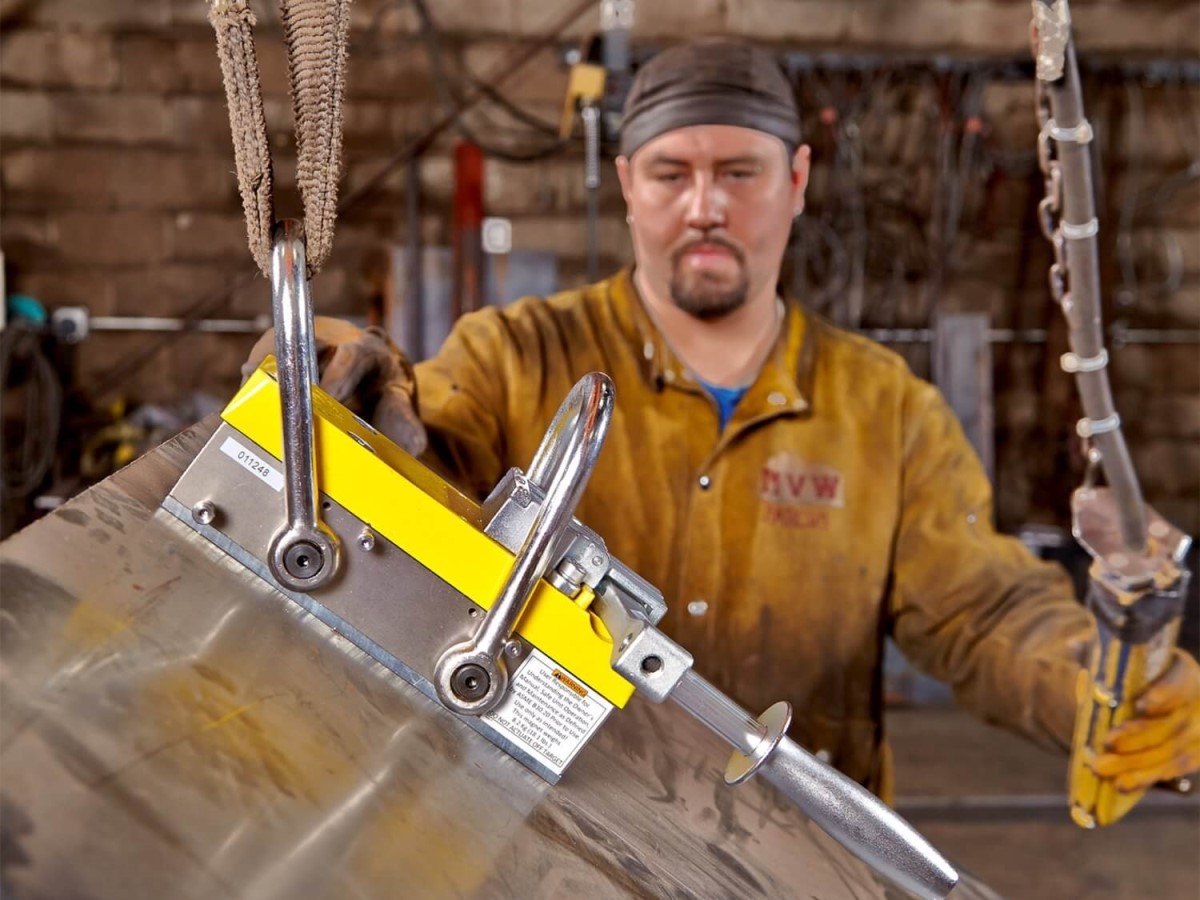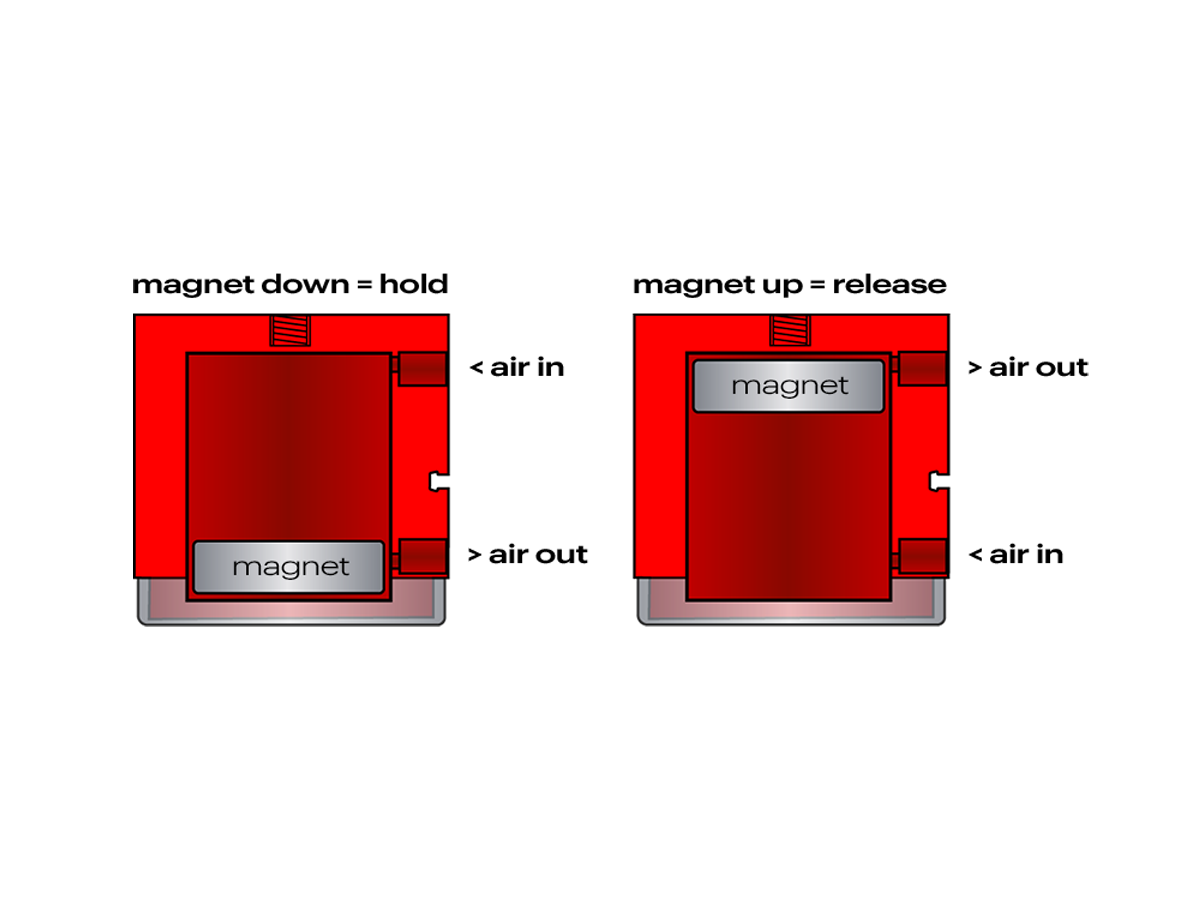About magnetic handling and lifting
Which magnet systems are there? How are they switched? And what does this mean for safety?
The information below applies to our magnets for lifting and handling.
Safety of lifting magnets
Safety and reliability are the most important criteria when lifting with magnets.
Permanent or electro lifting magnets
Magnetic lifting can be done with both permanent and electromagnets. They are both switchable, but there are also differences:
- Permanent lifting magnets are compact and always function: they retain their magnetic force.
- Electro lifting magnets need electricity to create a magnetic field. They switch quickly and without wear, and also lift heavy loads. But they run the risk of the load falling if the power goes.
That is why electro lifting magnets are always provided with an (expensive) back-up system.
Safety factor
You want to minimise the risks when working with lifting and hoisting equipment. That is why you should also take into account a safety factor in accordance with the EN13155 standard for the recommended workload:
- factor 2 for electromagnets and vacuum;
- factor 3 for permanent and electropermanent systems.
Risk analysis
When lifting objects, it is important to conduct a risk analysis beforehand. A good lifting system is a combination of the magnet, the suspension and the control system.
In areas where people are endangered by a load falling from a lifting magnet, you must take measures that limit the fall distance to a maximum of 1.5 meters.
This limitation does not apply, however, if you install a retention device - fall protection, such as a chain - that will catch and hold the falling load. Keep in mind that such a retention device reduces the ease of use.
When lifting heavy loads, you should also pay attention to the swaying of the load. In this situation, the weights are so high that they cannot be easily corrected by hand.
Lifting magnets switching systems
What is monostable and bistable, and how do permanent and electro lifting magnets switch?
Monostable magnet systems are only on or off as long as they are supplied with an electrical or pneumatic switching signal. As soon as this signal is lost, the system switches back to its ‘idle state’. An electro lifting magnet is always monostable and always off when idle. In contrast, permanent systems can be on or off when idle.
Bistable magnet systems switch on or off by a switching signal. This remains until the next switching signal is given. For lifting and hoisting applications, a bistable system is safer than a monostable system because:
- the magnet can never switch off spontaneously, causing the load to fall;
- the magnet actually switches off, and can therefore not unexpectedly attract a steel sheet.
Bistable magnetic systems are always constructed with permanent magnets (or a combination of permanent magnets and electromagnets).
All Goudsmit lifting systems are bistable.
Permanent lifting magnets
Permanent lifting magnets can be switched manually, pneumatically or electrically:
- Manually switched
This type consists of 2 magnets, 1 of which can move with a lever or rotary knob. In the off position, the magnets are shorted so that they cancel each other out. In the on position, the magnets reinforce each other.
Examples: Magswitch hand lifter | Manual permanent lifting magnets | Switchable welding magnets - Pneumatically switched
The magnet is moved in a housing by means of compressed air so that no magnetism is present outside the housing in the off position, only in the on position (the movement is only internal). See the below image.
Examples: Magnetic grippers | Magswitch grippers | Switchable sheet separators | Palletizing magnets
- Electrically switchable permanent magnets
Monostable: the permanent magnet section lifts your product. The electromagnet part neutralises the permanent magnetic field and releases the product. This means that the magnet is ‘on’ when it is not supplied with power.
Bistable: an electrical signal rotates two permanent magnets relative to each other, either producing a magnetic field or aligning them such that they cancel each other out.
Example: Magswitch wireless electrically switched manual lifting magnet
Electromagnets
Electromagnets can only be switched electrically with direct current.
Lifting capacity influencing factors
Not only weight is important when picking up steel objects.
The maximum breakaway force is the force to pull the magnet from the product. The values on this site - in the specifications on the product pages - are indications. These are measured on a clean, flat steel sheet of a specific thickness: thick enough to absorb the full magnetic force. In practice, the maximum breakaway force is therefore not always feasible.
Lifting capacity factors
All the factors mentioned below collectively reduce the lifting capacity. To calculate the final reduction in lifting capacity, you have to multiply the various factors.
- Surface conditions/air gap
Lines of magnetic force pass through steel very easily and through air with difficulty. Anything that creates a space or air gap between a magnet and a load to be lifted reduces the lifting capacity of a magnet. This can be, for example, dirt, paper, moisture, burrs, rust or paint.
- Material
Steel with a low carbon content, such as St37, is nearly as good a conductor as iron. Alloys, however, contain non-magnetic materials, which impair magnetic conduction. AISI304, for instance, is a material that conducts magnetic field lines almost as poorly as air.
Heat treatments that affect the structure of the steel can also reduce the lifting capacity. The harder steel is, the poorer the lifting capacity. Hardened steel also often retains residual magnetism.
See below the lifting force for different materials:
St37 (0.1-0.3% C): 100%
Non-alloyed Steel (0.4-0.5% C): 90%
Cast steel: 90%
Alloy steel F-522: 80-90%
AISI430 (magnetic stainless steel): 50%
Cast iron: 45-60%
F-522 tempered (60 HRC): 40-50%
AISI304 (stainless steel/nickel): 0-10%
Brass, aluminium, copper, etc.: 0%
- Load thickness
The greater the number of field lines that can ‘flow’ from the magnet through the load, the higher the efficiency of the magnet. If the load is too thin, the material becomes saturated with field lines and not all field lines from the magnet can flow through the material. This reduces the lifting force. Only if the load is sufficiently thick is it possible to utilise the magnet’s full capacity. Once this point is reached, a greater material thickness will not result in any additional lifting capacity.
- Magnet contact surface on lifted load
If not the entire magnet surface makes contact with the load during lifting, the lifting capacity will be reduced in direct proportion.
- Bending of the lifted load
If a thin sheet is lifted with a single magnet, or if the load is much wider or longer than the contact surface of the magnet, the load will bend and 'peel off' of the magnet. This peeling effect greatly reduces the lifting capacity.
Therefore, lift thin plates with several magnets, evenly distributed over the entire surface. Make sure that the magnet contact surface is always in line with the load to be lifted and not transverse to the load length.
- Temperature of the load to be lifted
The higher the temperature, the faster the molecules in the steel move. Rapidly moving molecules are more resistant to an applied magnetic field and therefore result in a lower lifting capacity. The magnets used may be loaded up to a maximum of 80°C, otherwise they will become permanently demagnetized.
Magnets for use in higher temperatures are available on request.
- Stacking of the lifted load
A magnet is designed for a certain lifting capacity; this is for a single load to be lifted. A lifting capacity calculated for a single sheet 10 mm thick is not the same as for two sheets that are each 5 mm thick. If you want to lift more than one sheet/profile at a time, you must state this clearly when placing your order. The specialists at Goudsmit will determine how this can be done safely for you.
It is often undesirable that two or three sheets are picked up together when taking them from a stack. The last sheet can come loose during transport. For that reason, there are magnets with a shallow field for picking up thin sheets. If this is not enough, place sheet separators next to the stack of sheets so that they are always picked up one at a time.
Find the lifting or handling magnet for your application here.


